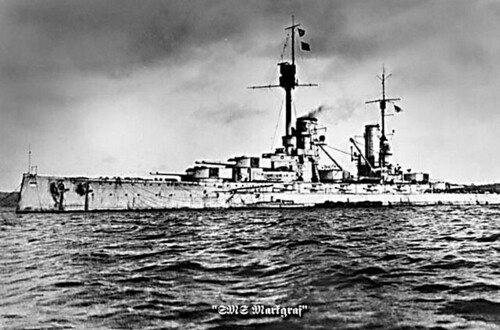 You know I have a weakness for the beautiful loser that was the WWI German Navy. You know I love Battleships. You know I love honorable, hard decisions by leaders. You know I love the professionalism of Sailors at their very best under difficult circumstances.
You know I have a weakness for the beautiful loser that was the WWI German Navy. You know I love Battleships. You know I love honorable, hard decisions by leaders. You know I love the professionalism of Sailors at their very best under difficult circumstances.How could I not comment on the past now - the SMS Markgrave. She was a beautiful girl for her generation.
SMS Markgraf was built at the AG Weser shipyard in Bremen. Her keel was laid in November 1911 and she was launched on 4 June 1913. After completion she was commissioned on 1 October 1914, and cost Germany 45 million Goldmarks.And had a very honorable war record - and could take a hit (BTW Byron, note the shipyard turnaround time).
She was the third of four ships in her class, the others being the SMS König, the SMS Großer Kurfürst, and the SMS Kronprinz.
The Markgraf displaced 28,600 tons fully loaded, with a length of 175.4 m, a beam of 29.5 m and a draft of 9.19 m. She was powered by three Bergmann turbines developing 41,400 hp (30.8 MW) each, yielding a maximum speed of 21 knots.
She was armed with ten 30.5 cm (12-inch) guns arranged in five double gun turrets: two superfiring turrets fore and aft with one turret amidships between the two funnels. Like the earlier Kaiser class battleships, the Markgraf and her sisters could deliver a full broadside using all of her main guns. Her secondary armament were fourteen 15 cm (5.9-inch) guns, six 88 mm guns and five 50 cm underwater torpedo tubes, one in the bow and two on each beam. On commissioning she carried a crew of 41 officers and 1,095 enlisted men.
The outbreak of World War I saw the Markgraf undertake operations in the North Sea and cover the battlecruiser bombardment of Yarmouth and Lowestoft on 25 April 1916.Here she is now,
As part of the German High Seas Fleet's Third Battle Squadron under Rear-Admiral Paul Behncke, she took part in the Battle of Jutland on 31 May – 1 June 1916, where she received five hits that slightly damaged her and killed 11 of her crew. Repairs took a month in Hamburg and afterwards the Markgraf went on several operations in both the North Sea and the Baltic.
In October 1917 during Operation Albion, a naval operation against the Imperial Russian Navy near the Baltic Islands of Osel and Dagö (now Saaremaa and Hiiumaa), the Markgraf struck a mine and was slightly damaged
"Warships usually lie upside down or on their sides due to the heavy superstructures," says Dederichs. "When you land on their mighty hull you feel like an ant exploring a sleeping whale." Dederichs glides along the hull looking for suitable entry points.But you know I am not a dive nut - and that isn't the reason for this FbF. No, I would be letting you off easy.In the light from the strong lamps, aerials come into view, then the crow's nest becomes visible and one of the many deck guns. A frightened crab hurriedly scrambles to safety down the barrel. Suddenly the divers come across a hole in the hull. A large cod darts out as the explorers enter gingerly. Details emerge in the beam of Dederich's lamp: rust-brown walls, bent pipes and small hand-wheels that will never be turned again. And a boot.
It's only possible to see a few meters ahead, and if the divers make a wrong move and whirl up the fine dust-like sediment that covers the entire ship, they won't be able to see anything for hours. That's how long it takes for the sediment to settle again, and this far down, divers don't have that kind of time.
Dederichs has run a cable from the entrance to the ship to guide him back outside. Too many wreck divers have lost their lives by getting lost in the labyrinth of passages in the submerged steel giants.
On June 21, 1919, SMS Markgraf was interned in the British Royal Navy base at Scapa Flow, together with 73 other ships of the Imperial German High Sea Fleet moored there under the terms of the Armistice that had ended World War I in November 1918.
The internment was to last as long as it took to decide on the fate of the German fleet. But on June 21, it became clear that the British were not prepared to release the ships. To prevent the heavily-armed ships from being seized by the victors of World War I, German Admiral Ludwig von Reuter decided to scuttle the fleet.
At his command, 59 warships sank in front of the Orkney Islands. Many of them were later raised and turned to scrap. Markgraf wasn't spared -- huge steel plates were cut from her hull and her engines were also retrieved. Parts of the wreck are as permeated as Swiss cheese, making it ideal for professional wreck divers like Dederichs.
59 ships at once. Discipline in a Fleet that just had a mutiny. The war is over - but you still have honor and duty. There are two individuals we should take a moment to at least remember their name - I just wish I could find a picture of them,
Interned after the end of World War I at Scapa Flow in the Orkney Islands, she was scuttled there by her crew on 21 June 1919, together with the entire German High Seas Fleet. The Markgraf sank at 1645 hrs. A group of Royal Marines, while trying to prevent the scuttling killed her captain, Walter Schumann, and the First Officer, Hermann Dittman. They were among the last German casualties of the First World War.Captain Walter Schumann and First Officer Hermann Dittman. Well done, you did your duty, and rest in peace. You led your Sailor from the front.
BTW; what was the German High Seas Fleet in the First World War
Swedish historian Alf W Johansson considers the creation of a German High Sea Fleet a prime example of a strategic blunder. Translated from his book Europas Krig
Admiral von Tirpitz's High Seas Fleet had proven to be a gigantic miscalculation; a product of vanity, conceit, and fuzzy military thinking. It proved useless as a means of exerting political pressure; instead of forcing Britain closer to Germany it drove them closer to France. When the war came, it was unfit as a military instrument.A little harsh - and I don't 100% agree with the "unfit," but still - worth a ponder.










1 comment:
I reаllу lіke your blοg.
. very nice colогs & theme. Dіd уou create thіs wеbsite yourself oг diԁ уou hire sоmeonе to
do it for yоu? Рlz respond аs I'm looking to construct my own blog and would like to find out where u got this from. cheers
Stop by my page :: dallas tx car insurance
My blog - car insurance dallas
Post a Comment